World War II
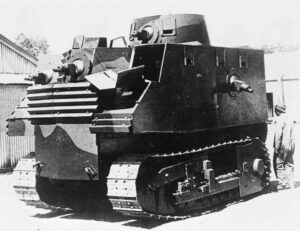 The making of the weapons of warfare is not always an easy task, and sometimes there is a lot of trial and error. When the different countries decided to begin making tanks, there were as many different styles as countries involved. That might sound like a good thing, but making an effective battle tank is no small undertaking, even in the best of times. Building one under the pressure of war is next to impossible. In fact, given the complexity of the machines, high costs, and stress of combat, I don’t know how they managed to make them work at all. Of course, not all tank designs were failures. There were a number of successful tanks, of course. If there hadn’t been we wouldn’t have tanks today. They would have just given up. Nevertheless, there were also a lot of failures.
The making of the weapons of warfare is not always an easy task, and sometimes there is a lot of trial and error. When the different countries decided to begin making tanks, there were as many different styles as countries involved. That might sound like a good thing, but making an effective battle tank is no small undertaking, even in the best of times. Building one under the pressure of war is next to impossible. In fact, given the complexity of the machines, high costs, and stress of combat, I don’t know how they managed to make them work at all. Of course, not all tank designs were failures. There were a number of successful tanks, of course. If there hadn’t been we wouldn’t have tanks today. They would have just given up. Nevertheless, there were also a lot of failures.
Tanks like the Bob Semple Tank, so named for the New Zealand politician tasked with designing it. Sadly, this dud was built with what limited materials or expertise, Semple and his team could get their hands on. The tank was designed after a picture on an American postcard. Basically, it was a tractor wrapped in steel with six 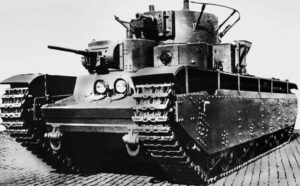 machine guns poking out at different angles. Ok, it might have looked like a tank, but that was about it. To change gear, it had to come to a complete stop…not a good way to ward off the enemy. One of the gunners of the eight-man crew had to lie on a mattress to squeeze into the cramped compartments, so he was pretty much done for it if the tank caught fire.
machine guns poking out at different angles. Ok, it might have looked like a tank, but that was about it. To change gear, it had to come to a complete stop…not a good way to ward off the enemy. One of the gunners of the eight-man crew had to lie on a mattress to squeeze into the cramped compartments, so he was pretty much done for it if the tank caught fire.
In true Hitler style, the Panzer VII Maus was the largest tank ever built. The size of the tank was its biggest downfall. The tank used too much fuel to be a logical option for a country running low on funds. In addition, the tank was so huge that it couldn’t maneuver through tree covered areas, and it was so slow that it couldn’t catch other tanks. It was also a sitting duck for aircraft looking to bomb it, because it just went so slowly.
The T-35, built in the Soviet Union, was the pride of the Red Army…until it was actually used in combat. This tank was outdated before it was built. A five-turret behemoth, it was a battleship on some seriously slow-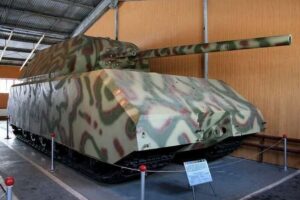 moving treads. About the only thing it was good for was looking good in a parade. On the field…well, that was another matter. The T-35 required a 10-man crew to operate and many more to maintain. More than half of the 48 tanks used in the first attack in 1941, broke down before reaching the front.
moving treads. About the only thing it was good for was looking good in a parade. On the field…well, that was another matter. The T-35 required a 10-man crew to operate and many more to maintain. More than half of the 48 tanks used in the first attack in 1941, broke down before reaching the front.
Of course, there were other duds too. Probably too many to mention here. The tank was a good idea, and the good ones were like a rolling force field. The problem was that the ones that were poorly designed, rather outnumbered the ones that were good. I suppose that is why there are relatively few tank designs.

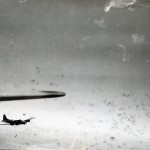 There are many heroes is a war, and World War II is no exception. Because my dad, Allen Spencer served on a B-17, and was a Flight engineer and Top Turret Gunner, I have always had a special spot in my heart for the Flying Fortress. After all it is the plane that safely brought my dad back from the war so he could be my dad. Most people, who know anything about the B-17, know that the most dangerous station on the B-17 is the Ball Turret. In fact, the average life span of a ball turret gunner in battle is 12 seconds…seriously!! The bad thing for the ball turret gunner is that because it is a small space, the job goes to the smallest man in the group, and if there isn’t anyone who is 5’7″ or shorter, they have to find one. That is basically how Frank Perez ended up in that spot. It was very unexpected, because he trained in Biloxi, Mississippi at the B-24 training base, so it was expected that he would be assigned to a B-24.
There are many heroes is a war, and World War II is no exception. Because my dad, Allen Spencer served on a B-17, and was a Flight engineer and Top Turret Gunner, I have always had a special spot in my heart for the Flying Fortress. After all it is the plane that safely brought my dad back from the war so he could be my dad. Most people, who know anything about the B-17, know that the most dangerous station on the B-17 is the Ball Turret. In fact, the average life span of a ball turret gunner in battle is 12 seconds…seriously!! The bad thing for the ball turret gunner is that because it is a small space, the job goes to the smallest man in the group, and if there isn’t anyone who is 5’7″ or shorter, they have to find one. That is basically how Frank Perez ended up in that spot. It was very unexpected, because he trained in Biloxi, Mississippi at the B-24 training base, so it was expected that he would be assigned to a B-24.
Frank expected to be assigned to a B-24 crew but due to the “needs of the service,” Frank was assigned to the Lieutenant John J Connolly crew of a B-17 Flying Fortress. The B-17 crew already had a flight engineer, so Frank was selected for the ball turret gunner position. Knowing what I know about the ball turret gunner and knowing that anyone who knew about the B-17 also knew about the life span of a ball turret gunner, I’m quite sure that Perez instantly felt just a little bit sick to his stomach…a feeling that would be justified later. Perez had to fly for a time with a different crew while his crew finished some training. Then, he contracted pneumonia, and he was down for a month.
Finally, on July 28, 1944, Perez started flying with his crew again. Their target was the synthetic oil and ammonia plant at Merseburg, Germany. As we know, all combat missions were dangerous, but for Perez, this particular mission to Ludwigshaven, Germany, would really test his faith. Ludwigshaven was the site of large marshalling (railway) yards and a railroad depot. When the bombing run was completed, the B-17s headed back to their base in England. One of the most dangerous parts of a bombing run is maneuvering through the anti-aircraft guns with their flak. Frank’s B-17 was hit by flak and began tumbling and rolling out of control as it quickly lost altitude from about 30 thousand feet. The plane was still over Germany, and Perez could not get out of the ball turret due to the centrifugal force created as the plane fell from the sky. All he could do is watch in horror as the ground got closer and closer. He called the pilot on the intercom. No answer. Then he called “anyone.” No answer. He had to assume that he was the only survivor left…and that would not be for long.
Perez was sure that his life was over, so he started to pray. He prayed, “Well, God, if this is the way it has to be, let it be.” It was a noble prayer, but as he said, “I was under tension and wanted to live. But when I said that, at that instant, everything was just as peaceful as it can get. [I] had my whole life flash before me…from the time I was a little kid to that moment. I mean just like a movie but going like that [he snaps his fingers]. It’s hard to explain…like if you get killed, so what…you just don’t care.” It was his way of resigning himself to his fate and, then…the B-17 pulled up.
The flak might have knocked them out, and some were likely injured, but they were alive. The plane flew in at treetop level with only two of the four engines working. The crew, in an effort to lighten the load, began throwing unnecessary equipment and supplies out of the plane. Perez was still in the ball turret, as he had been for the entire mission. Finally, he saw the White Cliffs of Dover on the English coastline and knew that they 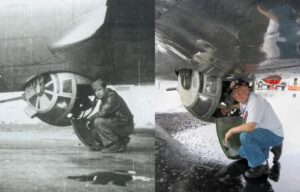
 were going to make it. The B-17 was able to land at a B-24 base in England, where it was repaired.
were going to make it. The B-17 was able to land at a B-24 base in England, where it was repaired.
After completing his required combat missions, Perez was discharged and sailed home to the United States. He was back in the US before December 16, 1944. Surviving the ball turret was the saving grace for Perez, who went on to live a long and fruitful life. He died January 16, 2015, two days after his 91st birthday.
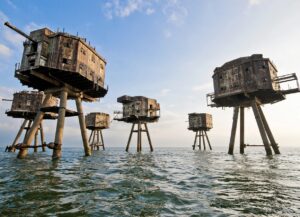 At the mouths of the Thames and Mersey rivers in the United Kingdom, you can still see what amounts to the remains of the Maunsell Forts. These forts are armed towers built during the Second World War to help defend the United Kingdom. At that time, they were operated as army and navy forts. They were named after their designer, Guy Maunsell. When the war ended, so did the need for the forts, and they were decommissioned in the late 1950s. They weren’t torn down, however, and were later used for other activities, including pirate radio broadcasting. Later it was found that they were not really stable enough for use, and the broadcasting stopped.
At the mouths of the Thames and Mersey rivers in the United Kingdom, you can still see what amounts to the remains of the Maunsell Forts. These forts are armed towers built during the Second World War to help defend the United Kingdom. At that time, they were operated as army and navy forts. They were named after their designer, Guy Maunsell. When the war ended, so did the need for the forts, and they were decommissioned in the late 1950s. They weren’t torn down, however, and were later used for other activities, including pirate radio broadcasting. Later it was found that they were not really stable enough for use, and the broadcasting stopped.
The Maunsell naval forts were built in the mouth of the Thames and operated by the Royal Navy. Their purpose was to deter and report German air raids following the Thames as a landmark and prevent attempts to lay mines by aircraft in this important shipping channel. There were four naval forts: 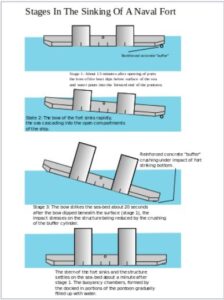 Rough Sands (HM Fort Roughs) (U1), Sunk Head (U2), Tongue Sands (U3), Knock John (U4). In reality it was an artificial naval installation, and it is similar in some respects to early “fixed” offshore oil platforms. “Each fort consisted of a rectangular 168-by-88-foot reinforced concrete pontoon base with a support superstructure of two 60-foot tall, 24-foot diameter hollow reinforced concrete towers. The walls were roughly 3.5 inches thick. The overall weight of each fort is estimated to have been approximately 4,500 tons. Everything was a useful space. The twin concrete supporting towers were actually divided into seven floors. Four of the floors were used for crew quarters. The rest of the floors were used for dining, operational, and storage areas for several generators, and for freshwater tanks and anti-aircraft munitions. There was a steel framework at one end supporting a landing jetty and crane which was used to hoist supplies aboard. The wooden landing stage itself became known as a ‘dolphin.'” A dolphin is “a group of pilings arrayed together to serve variously as a protective hardpoint along a dock, in a waterway, or along a shore; as a means or point of stabilization of a dock, bridge, or similar structure; as a mooring point; and as a base for navigational aids.”
Rough Sands (HM Fort Roughs) (U1), Sunk Head (U2), Tongue Sands (U3), Knock John (U4). In reality it was an artificial naval installation, and it is similar in some respects to early “fixed” offshore oil platforms. “Each fort consisted of a rectangular 168-by-88-foot reinforced concrete pontoon base with a support superstructure of two 60-foot tall, 24-foot diameter hollow reinforced concrete towers. The walls were roughly 3.5 inches thick. The overall weight of each fort is estimated to have been approximately 4,500 tons. Everything was a useful space. The twin concrete supporting towers were actually divided into seven floors. Four of the floors were used for crew quarters. The rest of the floors were used for dining, operational, and storage areas for several generators, and for freshwater tanks and anti-aircraft munitions. There was a steel framework at one end supporting a landing jetty and crane which was used to hoist supplies aboard. The wooden landing stage itself became known as a ‘dolphin.'” A dolphin is “a group of pilings arrayed together to serve variously as a protective hardpoint along a dock, in a waterway, or along a shore; as a means or point of stabilization of a dock, bridge, or similar structure; as a mooring point; and as a base for navigational aids.”
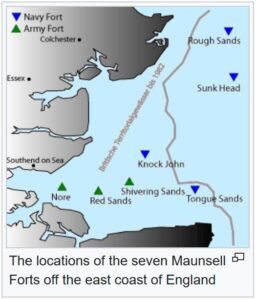
“The towers were joined together above the waterline by a steel platform deck. Other structures could be added as needed. That area was also the gun deck, on which an upper deck and a central tower unit were constructed. QF 3.7 anti-aircraft guns were positioned at each end of this main deck, and two Bofors 40 mm anti-aircraft guns and the central tower radar installations atop a central living area that contained a galley, medical, and officers’ quarters. The design of these concrete structures is equal to a military grade bunker, due to the ends of the stilts, (under water) that are solidly locked into the ground. They were laid down in dry dock and assembled as complete units. They were then fitted out, and the crews went on board at the same time for familiarization, before being towed out and sunk onto their sand bank positions in 1942.” They also had some unexpected uses. Many species of fish live near the forts because the forts create cover…who would have thought about that. The forts have also provided landmark references for shipping…an added perk.
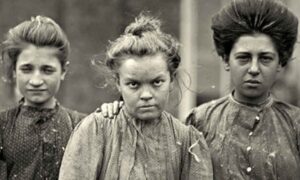 In the toughest of times, the women of the west had to participate in the work force since families had to make ends meet any way they could. But the work was demanding, often outdoors and with physical labor and lots of hours doing agricultural and other large-scale jobs. By the end of the day, they were exhausted…just like their men. It’s not that women aren’t capable of hard work, because they absolutely are. Nevertheless, their bodies aren’t built for the same kind of work as the men…or at least it isn’t as easy as for the men.
In the toughest of times, the women of the west had to participate in the work force since families had to make ends meet any way they could. But the work was demanding, often outdoors and with physical labor and lots of hours doing agricultural and other large-scale jobs. By the end of the day, they were exhausted…just like their men. It’s not that women aren’t capable of hard work, because they absolutely are. Nevertheless, their bodies aren’t built for the same kind of work as the men…or at least it isn’t as easy as for the men.
During World War I and World War II, when so many men were called to duty, and so many were killed, the workforce at home was dramatically shrinking. So, like they always did, the women stepped up. It’s not that the men weren’t stepping up too, 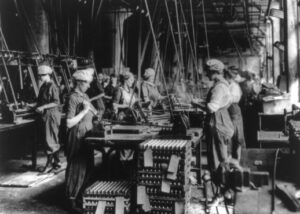 because going to war is most certainly stepping up. Really, everyone was doing a job that was not in their normal wheelhouse. Times were tough and tough times called for tough people. It the war was going to be won, the military had to be supplied with the necessary materials to fight with. Things like ammunition, uniforms, boots, tanks, planes, bombs, guns, and much more were vital; and without the help of the women back home, the men would not have the things they needed to win the war.
because going to war is most certainly stepping up. Really, everyone was doing a job that was not in their normal wheelhouse. Times were tough and tough times called for tough people. It the war was going to be won, the military had to be supplied with the necessary materials to fight with. Things like ammunition, uniforms, boots, tanks, planes, bombs, guns, and much more were vital; and without the help of the women back home, the men would not have the things they needed to win the war.
The thing about these particular women was that at that time in history, most women were stay-at-home moms, and at that time that really meant cleaning the house, cooking, and caring for the children. These were not times of going to the gym to work out, and the main exercise was the daily chores. Don’t get me wrong, because the chores 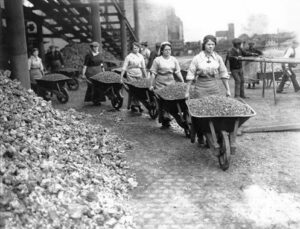 were hard work, and that did keep the women in shape, but they weren’t miners or factory workers. This necessary work was all new to them. The endeavor to bring these women into the workforce was no small undertaking. The had to be trained and trained quickly. There was no time to waste. The women, for their part, jumped at the chance to help their men and the men of the nation. They learned their new jobs quickly and did their jobs efficiently. They were loyal to their men and their country, and they were willing to take on the exhausting jobs they were asked to take on. In fact, I don’t think the wars could have been won, without both parts…the men and the women, and the necessary work they did.
were hard work, and that did keep the women in shape, but they weren’t miners or factory workers. This necessary work was all new to them. The endeavor to bring these women into the workforce was no small undertaking. The had to be trained and trained quickly. There was no time to waste. The women, for their part, jumped at the chance to help their men and the men of the nation. They learned their new jobs quickly and did their jobs efficiently. They were loyal to their men and their country, and they were willing to take on the exhausting jobs they were asked to take on. In fact, I don’t think the wars could have been won, without both parts…the men and the women, and the necessary work they did.

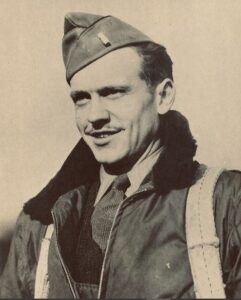 Because my dad, Allen Spencer was the flight engineer and top turret gunner on a B-17G in World War II, the B-17 has always held my interest. The plane was practically indestructible because of its great flying characteristics, resistance to combat damage, and fierce defensive firepower. Built by Boeing, it was called the B-17 Flying Fortress and it was the backbone of the American bomber force in Europe. In the European Theater of World War II (1939-1945), “one of the most dangerous occupations for Allied soldiers, sailors, or airmen was the flying of strategic bombers.” That was a statement that surprised me a little, because I would have expected the men on the ground to be in far more danger. I knew that there was a time my dad had to hang out of the open bomb bay doors to crank the landing gear down when they were damaged in combat, and I vaguely recall that they lost a ball turret gunner when he was wounded in battle and, while they pulled him out to render aid, they couldn’t save him.
Because my dad, Allen Spencer was the flight engineer and top turret gunner on a B-17G in World War II, the B-17 has always held my interest. The plane was practically indestructible because of its great flying characteristics, resistance to combat damage, and fierce defensive firepower. Built by Boeing, it was called the B-17 Flying Fortress and it was the backbone of the American bomber force in Europe. In the European Theater of World War II (1939-1945), “one of the most dangerous occupations for Allied soldiers, sailors, or airmen was the flying of strategic bombers.” That was a statement that surprised me a little, because I would have expected the men on the ground to be in far more danger. I knew that there was a time my dad had to hang out of the open bomb bay doors to crank the landing gear down when they were damaged in combat, and I vaguely recall that they lost a ball turret gunner when he was wounded in battle and, while they pulled him out to render aid, they couldn’t save him.
What I didn’t know about was something that happened on January 1, 1945, that was so bizarre that it seems like a ‘tall tale’ more than an actual event. Nevertheless, it was an actual event, and it was shocking. On that day, the Flying Fortress and the men who flew them were going to be tested beyond any limits they could have imagined, and beyond anything they were trained for. During a chaotic battle complete with ferocious anti-aircraft gunfire (flak) and enemy fighters, two B-17 Bombers managed to collide. A B-17, number 43-338457, piloted by 1st Lieutenant William G MacNab and 2nd Lieutenant Nelson B Vaughn, had risen upward. The top turret guns on MacNab’s plane had pierced through the aluminum skin on the bottom of 1st Lieutenant Glenn H Rojohn’s B-17, number 42-231987, binding the two huge planes together, as Rojohn’s co-pilot 2nd Lieutenant William G Leek, Jr said, like ‘breeding dragonflies.’ The two planes had become one. Upon impact, instead of exploding or breaking into pieces, the colliding planes became stuck together in a piggyback fashion, one atop the other. I’m sure that the men in the top plane, at least were in shock at this strange turn of affairs. I say the top plane, because it is thought that the men in the bottom plane were incapacitated or dead. There was no communication with them. Once the men realized that they weren’t going to crash, they would have to figure out their next move.
Even more shocked than the crew of the B-17 were the German fighter pilots who suddenly saw the whole confusing, but disastrous event. People just don’t expect that a mid-air collision could result in two planes stuck together. For the German fighter pilots, however, the situation took on an even more bizarre tone, because they honestly thought that the US must have created some sort of new secret weapon!! For the men onboard, the situation was dire. I’m sure they expected the explosion to come at any moment, so some of the airmen bailed out. The pilot of the top bomber, Rojohn tried, but was unable to separate the aircraft. Strangely, he was able to control the flight of the ‘hybrid dual-bomber’ somehow, despite turning his own engines off. The lower plane’s engines were still running, because its propellers were still turning. There was no communication with the crew of the bottom plane, which is why it was assumed that they were either incapacitated or already dead.
In a valiant effort, Rojohn decided to try to land the planes, probably hoping that the other crew could be saved, and complicated by the fact that he and his co-pilot, Leek couldn’t get out anyway. At that point, he might as well do his best to save the two or more of them that he could. He coaxed the joined bombers to a relatively safe landing in Germany at Wilhemshaven. Unfortunately, the lower bomber slid out from under the top bomber upon landing and immediately exploded. While the crew of the lower bomber perished in the landing and subsequent explosion, most of the crew of Rojohn’s B-17 survived and was taken prisoner. While being held in the camps, the German interrogators, who were skeptical of the account of the incident given by 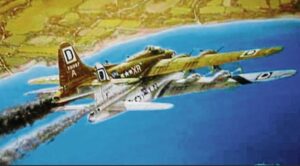
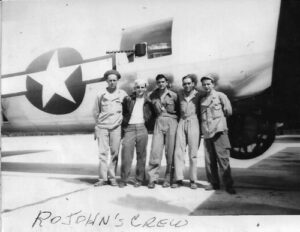 Rojohn, initially were of the opinion the flight represented a new American aerial design. I’m sure they later realized their error, but they must have also realized the resiliency of the B-17 Flying Fortress. Rojohn and his co-pilot, Leek, earned the Distinguished Flying Cross for their feat of aerial skill…a well-deserved award, if you ask me.
Rojohn, initially were of the opinion the flight represented a new American aerial design. I’m sure they later realized their error, but they must have also realized the resiliency of the B-17 Flying Fortress. Rojohn and his co-pilot, Leek, earned the Distinguished Flying Cross for their feat of aerial skill…a well-deserved award, if you ask me.
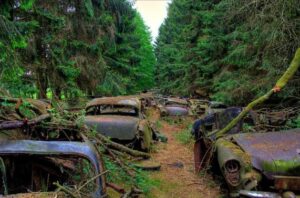
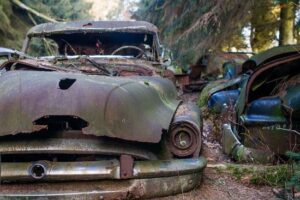 Just outside the little village of Chatillon in Southern Belgium, on top of a tree covered hill, hidden from view, there was a “car cemetery” filled with cars that once belonged to the US servicemen stationed there. No one really knows how the soldiers came to obtain the cars exactly, especially since they were mostly American made cars…meaning they must have been shipped over to Belgium. So, the soldiers who were stationed in Belgium during World War II somehow had cars to drive to get around while they were serving over there.
Just outside the little village of Chatillon in Southern Belgium, on top of a tree covered hill, hidden from view, there was a “car cemetery” filled with cars that once belonged to the US servicemen stationed there. No one really knows how the soldiers came to obtain the cars exactly, especially since they were mostly American made cars…meaning they must have been shipped over to Belgium. So, the soldiers who were stationed in Belgium during World War II somehow had cars to drive to get around while they were serving over there.
Then, once the war was over, the soldiers returned to the United States. I suppose that bringing the vehicles over happened a few at a time, but shipping them back would be a massive undertaking, so it was decided to leave them behind. To me, it would seem like they should have given the cars away. At least that way, people in the area could have a car, when they might not have been able to afford one any other way. Nevertheless, that was not how it was done. The officers in charge decided to leave them in the country and parked them all up at the top of a hill, which was hidden from view. It was left up to the individual soldier whether or not they wanted to have their car shipped to them once they returned home, at their own expense. Not one of them decided to retrieve their car. These days the way things took place in the end, would have very likely cause an international uproar because they basically littered the landscape with junk cars. Of course, they weren’t junk at the time, and I suppose the people of the area could have taken the cars as abandoned. I’m not sure how they would have run when it was finally determined that they were abandoned, and maybe it was decided that it would cost too much. That may be the reason that none of the soldiers ever claimed their vehicles…a cost too heavy and no help in sight.
After many years, the forest was in the process of making very slow work of returning the cars to nature. The stories about the “Car Cemetery” persisted, and possibly complaints too. It was said that American-made cars had been brought by American and Canadian NATO troops to a mechanic in Châtillon. One by one, the cars were driven up a hill, parked, and somehow hidden from the outside world. Eventually, local people added their own old cars too. Possibly the mechanic was to keep them for the soldiers, but after France’s 1966 withdrawal from NATO, he was left “holding the bag” as it were, with hundreds of scrap cars that gradually became overgrown until a television documentary brought the “illegal dump” to light. Finally, the cars were removed and crushed in October 2010.
To date, some of the cars are said to still be there. At one point there was not one but four car graveyards 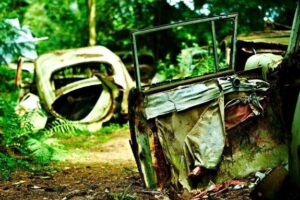
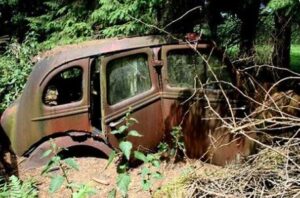 around the village of Chatillon with as many as 500 vehicles. The ones that remain today are only a fraction of the original number of cars. A lot of cars and their parts were stolen by the locals and international car collectors, so maybe some of them have been restored before they were completely lost. Either way, it was a very strange situation.
around the village of Chatillon with as many as 500 vehicles. The ones that remain today are only a fraction of the original number of cars. A lot of cars and their parts were stolen by the locals and international car collectors, so maybe some of them have been restored before they were completely lost. Either way, it was a very strange situation.
 In what reality is an “invisible” army a thing…much less important? Well, the answer is…in World War II. During that war, in which battles were being fought against multiple enemy nations, of multiple fronts, the British needed a little unusual help with the different fronts. In actuality, no British Fourth Army ever took the field. That didn’t mean that they weren’t very effective in their work. but they existed as part of the deception plans Operation Cockade and the later Operation Fortitude North. During these operations, the Germans were encouraged to believe that a Fourth Army had been established with its headquarters in Edinburgh Castle, and that it was preparing to invade Norway. Britain’s “Fourth Army” was successful in drawing and keeping the German units away from the real invasion zone in Normandy. Then, in the subsequent ‘Fortitude South’ the Fourth Army with different units was presented as part of the fictitious First United States Army Group (FUSAG) in its threat to the Pas de Calais.
In what reality is an “invisible” army a thing…much less important? Well, the answer is…in World War II. During that war, in which battles were being fought against multiple enemy nations, of multiple fronts, the British needed a little unusual help with the different fronts. In actuality, no British Fourth Army ever took the field. That didn’t mean that they weren’t very effective in their work. but they existed as part of the deception plans Operation Cockade and the later Operation Fortitude North. During these operations, the Germans were encouraged to believe that a Fourth Army had been established with its headquarters in Edinburgh Castle, and that it was preparing to invade Norway. Britain’s “Fourth Army” was successful in drawing and keeping the German units away from the real invasion zone in Normandy. Then, in the subsequent ‘Fortitude South’ the Fourth Army with different units was presented as part of the fictitious First United States Army Group (FUSAG) in its threat to the Pas de Calais.
The Fourth Army was always a “fictitious field army.” It first came into being as part of the British Expeditionary Force during the World War I. It was actually formed on February 5, 1916, under the command of General Sir Henry Rawlinson. The plan was for this fictitious army to carry out the main British contribution to the Battle of 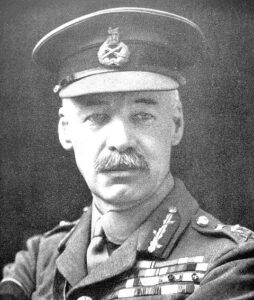 the Somme, but they quickly saw how effective a rumor could be in a war situation, and that is truly what this was. Basically, the word is sent out that a huge army is blocking a front that the enemy is trying to reach, or that they are planning to attack the enemy on a different front. So, the enemy decides to take another route…often a longer route, or in response to the rumored attack, the enemy sends it troops to the wrong place all together…only to find out they have been duped.
the Somme, but they quickly saw how effective a rumor could be in a war situation, and that is truly what this was. Basically, the word is sent out that a huge army is blocking a front that the enemy is trying to reach, or that they are planning to attack the enemy on a different front. So, the enemy decides to take another route…often a longer route, or in response to the rumored attack, the enemy sends it troops to the wrong place all together…only to find out they have been duped.
It must have been awful to take the troops into what is expected to be a battle, only to find out that they had been fooled. Imagine how that would make you look to your troops. The intel was completely false, and they fell for it. That must have made they feel very stupid on top of the fact that they wasted a lot of time on an imaginary enemy. While the Germans, in this case, looked incredibly stupid, it made the British Army look quite wise. Who would have thought that “make believe” could be such an effective weapon of warfare?
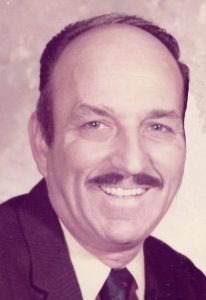
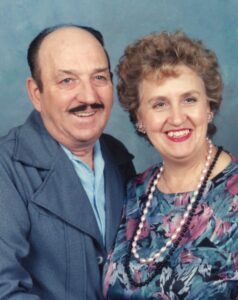 I never thought that at 51 years old, I would be saying “goodbye for now” to my dad, Al Spencer. Dad was 83 years old when he went to be with the Lord on December 12, 2007, but he never seemed like he was 83. Now, I can’t believe he has been gone 15 long years. Dad told me once that after you reach 18, you never feel any older. I’m sure there are people who would disagree with that statement, but I believe that it is statements like that made by people who truly believe it, that allow them to stay young. Dad always seemed young to me…right up until he left us. Even after surgery and a very long, drawn out recovery, he still seemed young, or maybe young at heart. He loved to tease his girls and the grandchildren, who loved to run past his chair to see if they were quick enough to get by before Grandpa could swat them. Mostly they were too slow, but they were delighted when they got away with it. Dad was always making jokes, and it really made his day when he could make people laugh. He loved having a house filled with joy.
I never thought that at 51 years old, I would be saying “goodbye for now” to my dad, Al Spencer. Dad was 83 years old when he went to be with the Lord on December 12, 2007, but he never seemed like he was 83. Now, I can’t believe he has been gone 15 long years. Dad told me once that after you reach 18, you never feel any older. I’m sure there are people who would disagree with that statement, but I believe that it is statements like that made by people who truly believe it, that allow them to stay young. Dad always seemed young to me…right up until he left us. Even after surgery and a very long, drawn out recovery, he still seemed young, or maybe young at heart. He loved to tease his girls and the grandchildren, who loved to run past his chair to see if they were quick enough to get by before Grandpa could swat them. Mostly they were too slow, but they were delighted when they got away with it. Dad was always making jokes, and it really made his day when he could make people laugh. He loved having a house filled with joy.
My dad lived an amazing life. He was raised on a farm in the Holyoke, Minnesota area. He went on a number of trips with his older brother, looking for work in the depression years, and then went to California to work for Douglas Aircraft. It really seems that it was this move that would bring him to his World War II destiny. After 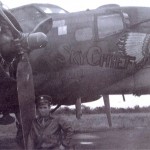
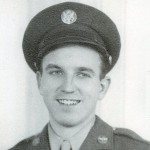 spending time building planes for Douglas Aircraft Company, the Army Air Forces saw in my dad, that he would be the perfect Flight Engineer and Top Turret Gunner on a B-17 crew, and that was how he spent his wartime service, stationed in Great Ashfield, Suffolk, England. While he never really spoke about it, my mom, Collene Spencer and sisters, Cheryl Masterson, Caryl Reed, Alena Stevens, Allyn Hadlock, and I have always been so proud of him and his service.
spending time building planes for Douglas Aircraft Company, the Army Air Forces saw in my dad, that he would be the perfect Flight Engineer and Top Turret Gunner on a B-17 crew, and that was how he spent his wartime service, stationed in Great Ashfield, Suffolk, England. While he never really spoke about it, my mom, Collene Spencer and sisters, Cheryl Masterson, Caryl Reed, Alena Stevens, Allyn Hadlock, and I have always been so proud of him and his service.
Dad traveled to other countries, but in his opinion, the United States was the best country in the whole world, although I’m sure he would have loved to have seen Israel. Dad took our family on yearly vacations…every year, without fail, so we could see what a wonderful country we lived in. My mom, sisters, and I were treated to so many places, with the Black Hills being one of his favorites. He loved the beauty of the area, but more importantly, he loved the patriotism of the area. After his passing, when my husband Bob and I went to the Black Hills for our annual trip to the area, I always felt like I could hear my dad’s echo telling us about the area, and how proud he was to be an American. I like to think of him there, because it was one of the places where he was the happiest.
Dad loved God, family, and country. He was a true Christian, and wonderful husband and dad, and he was a 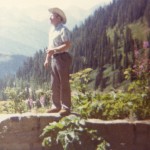
 true patriot. He was raised in church, and he and our mom raised their girls in the church. We know who we are, and we know that our God loves us, just like He loves our parents. Now that our parents live in Heaven, I know that they are watching over us and we try to live lives that we know will make them proud. We all miss then terribly, but we know that they are in our future now, and not in our past. We look forward to seeing them again soon. We love you both Dad and Mom, and we wish you were still here.
true patriot. He was raised in church, and he and our mom raised their girls in the church. We know who we are, and we know that our God loves us, just like He loves our parents. Now that our parents live in Heaven, I know that they are watching over us and we try to live lives that we know will make them proud. We all miss then terribly, but we know that they are in our future now, and not in our past. We look forward to seeing them again soon. We love you both Dad and Mom, and we wish you were still here.
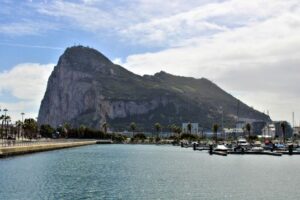 The Rock of Gibraltar is a unique rock located in the British territory of Gibraltar, near the southwestern tip of Europe on the Iberian Peninsula, and near the entrance to the Mediterranean. It is a huge monolithic limestone promontory that stands high above the water, although it actually sits on the edge of the land. During World War II, the rock was actually a war tool, and an amazing one at that. The British Army dug a maze of defensive tunnels inside the rock during the war, and the massive cliff is famous for the more than 30 miles of cleared space that served as a housing area for guns, ammunition, barracks, and even hospitals for wounded soldiers.
The Rock of Gibraltar is a unique rock located in the British territory of Gibraltar, near the southwestern tip of Europe on the Iberian Peninsula, and near the entrance to the Mediterranean. It is a huge monolithic limestone promontory that stands high above the water, although it actually sits on the edge of the land. During World War II, the rock was actually a war tool, and an amazing one at that. The British Army dug a maze of defensive tunnels inside the rock during the war, and the massive cliff is famous for the more than 30 miles of cleared space that served as a housing area for guns, ammunition, barracks, and even hospitals for wounded soldiers.
Recently, it was discovered that the rock held another, previously unknown secret use. Hidden in the famous rock is a secret chamber, known as the “Stay Behind Cave.” The cave measures 45 x 16 x 8 feet, and it has long been the site of a top-secret World War II plot called Operation Tracer. British Intelligence found out in 1940, that Hitler was planning to invade Gibraltar and cut off Great Britain from the rest of the British Empire. It was another part of their evil plan to take over the world, and they needed Britain out of the way to accomplish their objective. Once the British knew about this plot, the British Admirals suggested that a secret room be constructed within the Rock of Gibraltar, where six men would hide and observe from two small openings any movement they could see on the harbor. 
Six men were selected. One of the men even agreed to Operation Tracer before he was even told what it was. That fact doesn’t shock me as much as the other men knowing about it and still being willing to participate. The plan was to seal the six men inside the secret chamber with enough supplies to last them a year (some say the food stores could have actually carried the men for 7 years) was put into action. The plan had to take in any eventuality, so it was said that if one of the men were to die, they would be buried in the brick floor. The only way the men could escape back into the outside world would be if Germany was defeated before the year’s-worth of supplies ran out. Construction on the chamber began in 1941 and ended in 1942. It featured a radio room, 10,000 gallons of water, power generators, and other necessities.
The men were rigorously trained for the upcoming mission, but just before Operation Tracer could officially begin, Hitler changed course and started to focus more on the Eastern Front. The men were never required to begin their mission. The mission aborted, the equipment was removed and the section of the rock leading to the secret chamber was blocked off. The chamber was to be kept top secret. I suppose in case it was ever 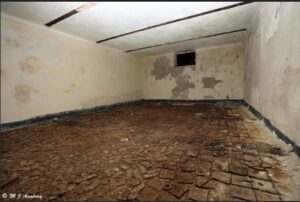 needed in a future war, but persistent rumors floated around about a secret chamber, and people continued to search for it. To me it is encouraging to know that it took people until December 26, 1996, to locate what they thought might be the chamber. That tells me that had the men been required to live in the room, they would probably have done so in absolute secrecy and safety. The suspicion about the room would persist for another decade, until finally, one of the six men who was supposed to partake in Operation Tracer confirmed that the room the explorers found in 1996, was indeed the room that was built for their top-secret operation all those years ago. It may be one of the best-kept secrets of World War II.
needed in a future war, but persistent rumors floated around about a secret chamber, and people continued to search for it. To me it is encouraging to know that it took people until December 26, 1996, to locate what they thought might be the chamber. That tells me that had the men been required to live in the room, they would probably have done so in absolute secrecy and safety. The suspicion about the room would persist for another decade, until finally, one of the six men who was supposed to partake in Operation Tracer confirmed that the room the explorers found in 1996, was indeed the room that was built for their top-secret operation all those years ago. It may be one of the best-kept secrets of World War II.

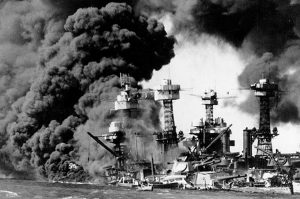 To call the Pearl Harbor attack, a “mistake on the part of the Japanese,” seems like a case of serious misinformation, on the part of the one who made such a comment, Admiral Chester A Nimitz. Nevertheless, that is what he said on Christmas Day, 1941, after he toured the destruction of his new duty station shortly after his Christmas Eve arrival. Anyone who would have heard Nemitz comments probably thought the new Commander of the Pacific Fleet might be just a little bit “off his rocker!!” Where everyone else saw all the ships sunken and knew of the 3,800 men who lost their lives that day, and in their minds, there was nothing good about all this, so what was the admiral thinking.
To call the Pearl Harbor attack, a “mistake on the part of the Japanese,” seems like a case of serious misinformation, on the part of the one who made such a comment, Admiral Chester A Nimitz. Nevertheless, that is what he said on Christmas Day, 1941, after he toured the destruction of his new duty station shortly after his Christmas Eve arrival. Anyone who would have heard Nemitz comments probably thought the new Commander of the Pacific Fleet might be just a little bit “off his rocker!!” Where everyone else saw all the ships sunken and knew of the 3,800 men who lost their lives that day, and in their minds, there was nothing good about all this, so what was the admiral thinking.
Sunday, December 7th, 1941, found Admiral Chester Nimitz attending a concert in Washington, DC. He received a page and was told that he had a phone call. On the other end was President Franklin Delano Roosevelt, who told Admiral Nimitz that his new assignment was to be the Commander of the Pacific Fleet. Admiral Nimitz flew to Hawaii to assume command of the Pacific Fleet, arriving to see such a spirit of despair, dejection, and defeat. It seemed that everyone thought the Japanese had already won the war. As the tour boat returned to dock, the young helmsman of the boat asked, “Well Admiral, what do you think after seeing all this destruction?” The admiral’s reply shocked everyone within the sound of his voice. Admiral Nimitz said, “The Japanese made three of the biggest mistakes an attack force could ever make, or God was taking care of America. Which do you think it was?” Shocked and surprised, the young helmsman asked, “What do mean by saying the Japanese made the three biggest mistakes an attack force ever made?”
What was meant, is really the difference between the thinking of an enlisted man, and the thinking of a great strategist, such as Admiral Nemitz was. I’m actually quite sure most of us would have fallen more in line with 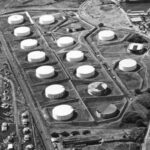
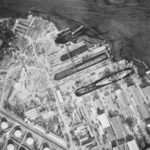 the enlisted helmsman…basically seeing the trees and missing the forest. So, Admiral Nemitz had to enlighten those around him. The first mistake made by the Japanese, is actually one I had heard before, and likely the “best” mistake for the people concerned. The attack on Pearl Harbor took place on a Sunday morning…when many of the men who might have been on the ships, were on leave. In fact, nine out of ten of the men stationed on the ships were on leave. That cut the loss of life down by 90%. As Admiral Nemitz told the people, “If those same ships had been lured to sea and been sunk–we would have lost 38,000 men instead of 3,800.” Now the Japanese had angered the “Sleeping Giant” that was the United States and left the majority of the fighting force to exact their revenge.
the enlisted helmsman…basically seeing the trees and missing the forest. So, Admiral Nemitz had to enlighten those around him. The first mistake made by the Japanese, is actually one I had heard before, and likely the “best” mistake for the people concerned. The attack on Pearl Harbor took place on a Sunday morning…when many of the men who might have been on the ships, were on leave. In fact, nine out of ten of the men stationed on the ships were on leave. That cut the loss of life down by 90%. As Admiral Nemitz told the people, “If those same ships had been lured to sea and been sunk–we would have lost 38,000 men instead of 3,800.” Now the Japanese had angered the “Sleeping Giant” that was the United States and left the majority of the fighting force to exact their revenge.
Of course, that was only their first mistake. Their second mistake was that when the Japanese saw all those battleships lined up in a row, they got so carried away sinking the battleships, they either didn’t notice, or forgot about the dry docks opposite those ships. Leaving the dry docks, meant that instead of towing every one of those ships to the America to be repaired, they could simply be raised from the shallow water they were in, and one tug could pull them over to the dry docks. Any salvageable ships could be repaired and back out at sea by the time they could have towed them to the America. Add that fact to the already established fact that Admiral Nemitz already had crews ashore anxious to man those ships. They were ready to fight.
The final mistake made by the Japanese was that they were either unaware of or forgot about the above-ground fuel storage tanks located just five miles away over the next hill. In fact, every drop of fuel in the Pacific theater of war was sitting out there in those tanks, and even if the ships were ready to go and fully manned, the lack of fuel would have prevented an attack on the Japanese fleet.
While everyone around him was thinking of the devastation and the defeat of the attack on Pearl Harbor, Admiral Nemitz saw the three biggest mistakes of the Japanese government, or as he preferred to call it, that 
 “God was taking care of America.” I tend to agree with Admiral Nemitz in that I, too, think it was God taking care of us. My thought is that the Japanese knew about the dry docks and the fuel storage, but in their “excitement” at pulling off the surprise attack, they forgot all about them. Of course, there is that first mistake of planning an attack of God’s Day. Seriously, they chose to take on the whole Pacific Fleet…and God too!! Wow!! It’s hard to be more “stupid” than that.
“God was taking care of America.” I tend to agree with Admiral Nemitz in that I, too, think it was God taking care of us. My thought is that the Japanese knew about the dry docks and the fuel storage, but in their “excitement” at pulling off the surprise attack, they forgot all about them. Of course, there is that first mistake of planning an attack of God’s Day. Seriously, they chose to take on the whole Pacific Fleet…and God too!! Wow!! It’s hard to be more “stupid” than that.

